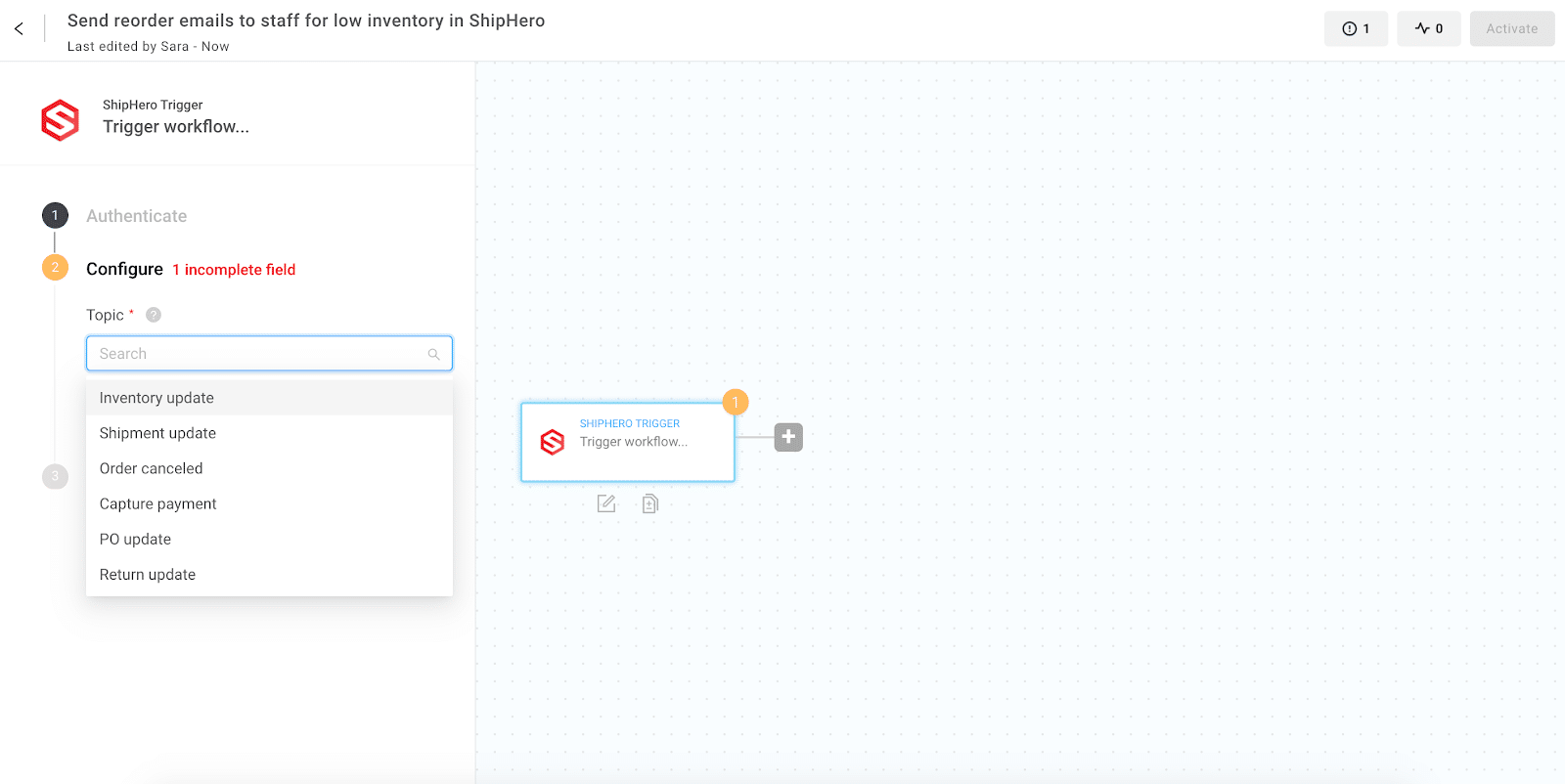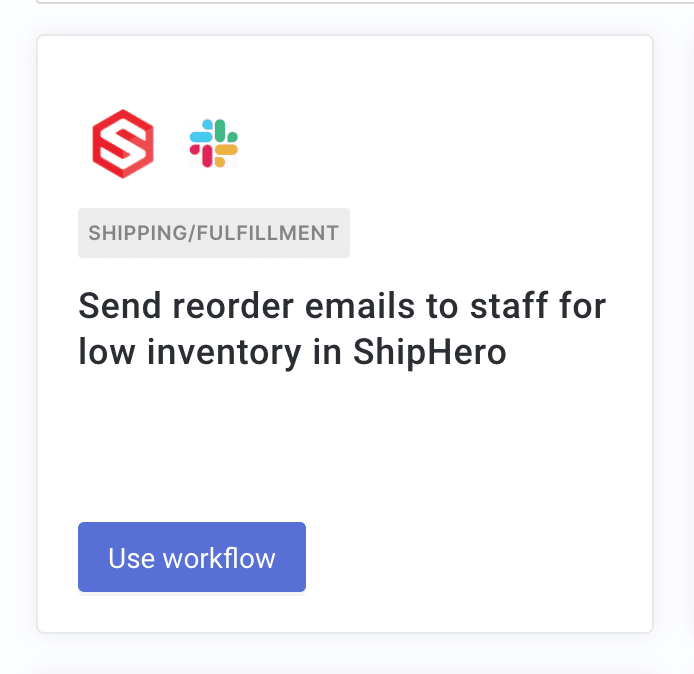
Dec 11, 2020 | 3PL Warehouse Management, Blog, Fulfillment, Warehouse Management Software, Warehouse Operations
ShipHero is very proud to announce its partnership with Alloy, a Silicon Valley-based provider of automation solutions for ecommerce. Alloy’s software allows you to automate your store’s marketing, operations, fulfillment, rewards, and much more.
With Alloy, you can easily set up automation to send emails and manage orders, freeing up time for you and your team. Alloy has over 200+ workflows that enable you to improve customer retention and ensure a greater customer experience overall.
Here is a screenshot showing the set up of a ShipHero workflow that triggers events from ShipHero. Data from ShipHero can then be sent to other apps. Users can add logic and conditions for filtering that data.

Recipe: Send reorder emails or Slack notifications to staff for low inventory in ShipHero
A great way to organize the flow of customer traffic and inventory is with our workflow.
Our workflow automates reorder emails to be sent to staff when there is low inventory in ShipHero. This ensures that your team can restock inventory at a reasonable pace and without over-stocking.
You can get setup with this workflow immediately by using Alloy’s prebuilt workflow recipe: https://app.runalloy.com/template-setup?id=5fd2801c2f8f2300139725d1

Recipe: Tag Shopify orders based on ShipHero delivery date
Tagging orders is a good way to stay organized especially when your store is expanding globally and there are multiple orders placed on the same day.
This workflow tags Shopify orders based on the ShipHero delivery date. This means that all orders are tagged by date allowing you to view which days are busy and how many orders are expected to ship out weekly.
Apps used: ShipHero, Shopify
Recipe: Set a ShipHero threshold to notify store owner of low inventory
Controlling inventory management can be stressful but with this well-equipped workflow, you can easily be notified of when your inventory is low in ShipHero. For instance, inventory levels are updated regularly and you receive inventory levels for each inventory item. When stock is low, you receive a notification.
Immediate notifications to store owners are key to restocking your inventory and satisfying your eager customers. These notifications can be sent through Slack and email.
Apps used: ShipHero
Recipe: If an order is still unfulfilled in ShipHero after 2 days, email me
Checking the fulfillment status can be time-consuming, especially when multiple orders need to be checked in ShipHero. It’s important to make sure your customers’ orders are sent out on time, but there’s a chance where your product might not be fulfilled by the expected date.
This automation will schedule a workflow after 2 days. Then, it will check to see if the order is unfulfilled for greater than or equal to 2 days. This will trigger an email notification to the store owner.
Apps used: ShipHero
Recipe: Automate fulfillment for Gorgias returns requests in ShipHero
You can automate customer service requests, specifically in shipping and support.
This workflow automates fulfillment for Gorgias return requests in ShipHero.
When a customer requests a return on Shippo, a Gorgias request is immediately created and sent. This frees up time from going back and forth between Shippo and Gorgias and ensures no information is lost.
Apps used: ShipHero, Gorgias
Recipe: Cancel ShipHero scheduled delivery if there is a Gorgias request
Customers will occasionally need to cancel their deliveries. But there’s no easy way for them to cancel a delivery for an order that’s already being fulfilled.
With this automation, customers can send in a support ticket for a cancellation request. Once your team marks it as a canceled order, an email is sent to the ShipHero fulfillment team so they won’t fulfill the order.
Apps used: ShipHero, Gorgias
Recipe: Send ShipHero delivery updates via Klaviyo SMS
SMS messages can have open rates as high as 98% and you’re not limited to using them for promotional campaigns. With this workflow, you can send delivery updates to customers through a text message to leverage higher open and engagement rates.
Here’s how it works: When a fulfillment event happens in ShipHero, a text message reminder is sent via Klaviyo to the customer that their order is out for delivery.
Apps used: ShipHero, Klaviyo
Alloy also has delivery update automations for Omnisend SMS, PostScript, SMSBump, and Tone.
Learn more about Alloy’s ShipHero integration here.
ShipHero is a leading provider of SaaS 3PL software for ecommerce fulfillment.

Dec 10, 2020 | Blog, Warehouse Management Software
Aaron Rubin is a longtime veteran of ecommerce. His growing annoyance with the shipping costs related to his business drove him to create ShipHero, a remote company that offers outsourced ecommerce fulfillment services and warehouse management software to other ecommerce businesses.
Recently, more than 1 in every 200 ecommerce packages delivered in America were shipped through ShipHero.
Aaron was interviewed on the Tropical MBA Podcast, discussing how his first ecommerce business nearly went bankrupt, how a need to “scratch his own itch” led to the creation of ShipHero, and offered his take on where the ecommerce industry is headed in the future.
Listen to the podcast here.

Dec 7, 2020 | Blog, News & Updates, Warehouse Management Software
Dearly Beloved,
We are gathered here today to honor the memory of our dear friend, Black Friday, or as her best friends affectionately called her, B.F.
Hear ye, Black Friday was a good Friday, surely not as good as Good Friday, but close. Nay, who could forget how Black Friday enticed all of the stuffed and happy Thanksgivingites to venture from their eating dens into the shoppe world, so that they may purchase holiday tokens and trinkets for their loved ones. She will truly be remembered as a barranger of holiday spirit and- what?
She’s… She’s just quarantined?!… But, CNN said so. They weren’t SURE? I had all this stuff prepared, unbelievable.
So, is Black Friday actually deceased like everyone predicted, or is she quarantined? What does the coroner have to say about the data?
Let’s Start With the Facts
For the sake of uniformity, and to get a bit nostalgic, let’s level-set on what Black Friday is/was.
Black Friday is the Friday after Thanksgiving and has been regarded as the beginning of the United States Christmas shopping season since 1952, with 30% of all shopping occurring between Black Friday and Christmas.
Since the rise of ecommerce, Black Friday has been widely regarded as the brick-and-mortar holiday, physically getting off your rump to purchase items, while Cyber Monday was the “celebration” of online sales.
To combat the hordes of rambunctious shoppers that would flock the stores every year, retail stores started opening earlier and earlier, even into Thanksgiving day. As such, retail stores in 2019 saw a 6.2% decrease in day-of Black Friday traffic with a 2.3% increase in Thanksgiving day traffic, hinting to a possibility that the Black Friday tradition may soon become obsolete.
Even way back in 2019, shoppers were becoming disillusioned with the Black Friday horror stories, avoiding the trampling crowds and opting to shop from the safety of their home. That may in part explain why Black Friday 2019 consumer spending hit a record $7.4 billion online.
Heading into 2020, experts and projections seemed to predict that this trend would continue, with in-store traffic steadily dwindling while online shopping carried the difference. But nobody could have predicted the actual outcomes.
Black Friday 2020
On Black Friday 2020, U.S. store traffic plummeted by 52% as retailers cut their hours and limited their deals in order to dutifully mitigate large gatherings.
Meanwhile, online shopping on Black Friday increased 21.6% YOY to $9.03 billion. If you’re thinking, a 52% decrease and a 22% increase, that doesn’t add up, well… you’re right.
According to statistics accumulated by Adobe Analytics, the month of November in 2019 reported $142.4 in online revenue, and the predicted online revenue for 2020 was a staggering $189 billion. So what did we actually hit? A mere $100 billion, basically a Jeff Bezos weekend.
People just weren’t in the mood to shop in November 2020… except in the case of Small Business Saturday which enjoyed about a 30% YOY growth, which makes sense because a Google research report this year indicated shoppers’ loyalty to small businesses has increased, as 66% say they plan to shop at local small businesses this holiday season.
So after looking at all these figures, can we definitively say that Black Friday has perished? That just seems so final. So permanent.
How COVID Measures Could Revive Black Friday
Consider this, the reason for Black Friday’s impending obsolescence was that shoppers and retailers alike couldn’t handle the large crowds. To address the problem, retailers didn’t implement a new system or improve their practices, instead they paid people more money to come in on a holiday.
Now may I ask, weren’t retailers recently pressured by a shall-remain-unnamed external force to implement a whole bunch of measures, like curbside pickup, contactless checkout and BOPIS, to avoid crowds altogether and improve the shopping experience?
These new omni-channel methods, while a result of necessity, could prove to be a big advantage when the holiday shopping floodgates open up next year in 2021: A Shop Odyssey.
Of course, this is just an optimistic perspective from a Black Friday enthusiast, but it will certainly be interesting to see how retailers employ their newfound capabilities in a post-COVID era of retail.
Push to Digital
Of all the mysteries shrouding Black Friday’s possible disappearance, there is still one very clear trend: the push to online sales for retailers.
Shopify Plus research data indicates the following trends for BFCM 2020:
- 80% of Shopify Plus merchants surveyed who are participating in BFCM plan to only offer online sales, while 20% plan to embrace a hybrid approach.
- 67% plan to sell through an online marketplace, including Amazon and Google Shopping.
- Most brands will offer some type of discount for BFCM, and most will provide a blanket discount on all items.
Not only that, ShipHero collected the following statistics:
- Cyber Monday volume was up 124.14% YOY, more than double that of 2019.
- For the Black Friday to Cyber Monday period, average order value was up 15.36% YOY, increasing to $91.59 from $79.40 a year ago.
- Also during this period, ShipHero total unit volume increased 104.06% YOY.
Online orders increased on both Black Friday and Cyber Monday. With the already overwhelmed fulfillment providers like Amazon, UPS and others reporting delays, volume restrictions or stalls in their fulfillment capabilities, more and more retailers are switching to alternative fulfillment providers. ShipHero saw a large growth in new customers, as well as revenue increases at existing customers.
As we continue to navigate the most wonderful and turbulent time of the year, ShipHero is here to meet your customers’ demands during the holidays and year-round, with fast and accurate order fulfillment. Find out more here.
Dec 3, 2020 | Blog, Warehouse Management Software, Warehouse Operations
With the explosion of e-commerce showing no signs of slowing, retailers are increasingly leaning on the technological capabilities and geographic reach of fulfillment providers to place inventories in position for faster last-mile services.
Retailers are placing a greater emphasis on e-commerce versus brick-and-mortar shopping as consumers continue to show hesitancy to shop in stores amid the COVID-19 pandemic. But that emphasis on e-commerce requires positioning inventory closer to the customer in order to shorten the last-mile. As a result, retailers are turning to fulfillment providers with cloud-based technology capabilities to manage their inventories in real-time.
ShipHero CEO Aaron Rubin was asked about the growing trend in ecommerce fulfillment where companies are attempting to place their inventory closer to their customers.
“Retailers will streamline operations, reduce brick-and-mortar presence, and outsource fulfillment to focus on their core service offerings,” Aaron Rubin told JOC.com.
He expects a continued shift from brick-and-mortar dependence to an ecommerce-focused model and noted that many bankrupt retailers with physical stores are relaunching as online retailers and ramping up quickly by utilizing ShipHero’s fulfillment network, which currently consists of seven US warehouses. ShipHero’s warehouse management system software is in 500 warehouses at present.
Read more here at Joc.com. (registration required)
Dec 1, 2020 | Blog, Fulfillment, Warehouse Management Software
ShipHero Ecommerce Order Fulfillment Update
Tuesday, December 1, 2020
ShipHero just completed another successful Black Friday and Cyber Monday, helping our SaaS and fulfillment customers meet their holiday order rush.
Cyber Monday volume was up 124.14% year-over-year, more than double that of 2019.
For the Black Friday to Cyber Monday period, average order value was up 15.36% year-over-year, increasing to $91.59 from $79.40 a year ago.
Also, during this period, ShipHero total unit volume increased 104.06% year-over-year. The more than doubling of orders is due to the growth new customers using ShipHero as well as sales increases at existing customers.
ShipHero is here to meet your customers’ demand during the holidays and year-round, with fast and accurate ecommerce order fulfillment. See what we can do for you here.




